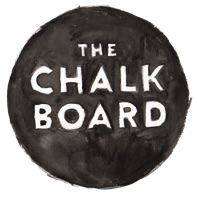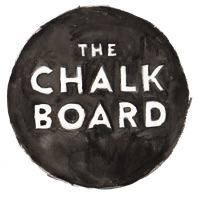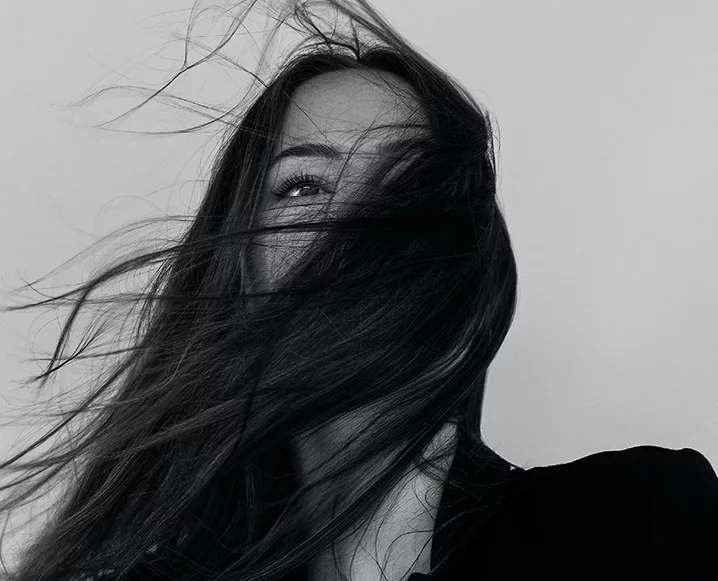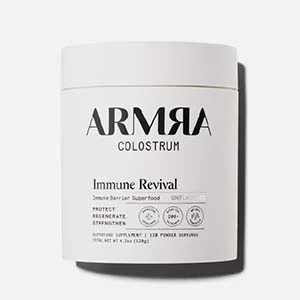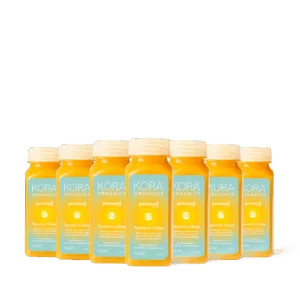Grey hair has long carried a reputation for arriving with shock, stress, or surrender, the “overnight silver streak,” the first rogue strand at the temple, the cues we’re taught to battle or hide. But in reality, greying is far more complex, rooted not in panic but in biology, longevity, and how we care for ourselves over time.
To move beyond folklore and fear, we turned to someone rewriting the conversation entirely: Jay Small, a certified trichologist and celebrity hairstylist who co-founded Arey, the first functional haircare brand proven to slow and repigment greys. Known as “the wrinkle cream of haircare,” Arey approaches aging hair the same way modern skincare approaches aging skin — proactively, scientifically, and with respect for the process.
In this conversation, Jay separates myth from science, explains what’s really happening when pigment fades, and shares the daily choices that truly influence how and when we go grey. From stress and sun exposure to nutrition and follicle health, this is the real story behind silver strands without the scare tactics.
The Truth About Going Grey
 One of the biggest myths is that stress turns hair grey overnight. What does the science actually show about stress and pigment loss? One of the biggest myths is that stress can turn hair grey overnight. The reality is more nuanced. While there aren’t human studies definitively proving that emotional stress directly causes greying, research in mice — and plenty of anecdotal evidence — suggests that stress can accelerate the process.
One of the biggest myths is that stress turns hair grey overnight. What does the science actually show about stress and pigment loss? One of the biggest myths is that stress can turn hair grey overnight. The reality is more nuanced. While there aren’t human studies definitively proving that emotional stress directly causes greying, research in mice — and plenty of anecdotal evidence — suggests that stress can accelerate the process.
Here’s what we know: each hair follicle contains a “factory” that produces melanin, the pigment that gives hair its color. Under stress, the body produces higher levels of cortisol, the hormone that helps us stay alert. Elevated cortisol can disrupt the hair growth cycle and slow pigment production. Over time — especially with chronic stress — this disruption may contribute to greying.
It’s also important to remember that we’re exposed daily to oxidative stressors from our environment, like UV rays, pollution, and even chemicals in certain hair products and foods. These stressors generate free radicals, which can damage the melanin-producing cells in hair follicles.
Ultimately, there are two types of stress that influence hair health and pigment: intrinsic stress (things like psychological strain and diet) and extrinsic stress (factors like sun exposure, pollution, and chemicals). Both play a role in pigment loss, but the process is gradual — not an overnight transformation.
Why do some people start greying in their 20s while others hold off until their 60s — is it all genetics, or do lifestyle and environment play a role? Greying isn’t determined by one factor alone. Beyond the IRF4 gene — the only gene so far directly linked to greying — lifestyle and environment also play important roles alongside biological aging.
Habits like smoking, high stress, poor diet, and frequent UV exposure can all accelerate greying. On the other hand, people who manage stress, eat nutrient-rich diets, and make healthy lifestyle choices may hold on to their natural color for longer.
Ethnicity is another factor. Hair thickness, density, shape, and natural color vary across populations, and researchers have found that these differences influence when greying begins — as well as what’s considered “premature” in different groups.
In short: genetics set the baseline, but lifestyle, environment, and even ethnicity all shape when and how quickly greying shows up.
What’s one thing people unknowingly do every day that accelerates greying? One of the most common — and overlooked — accelerators of greying is sun exposure. We’ve learned to prioritize SPF for our face, neck, and body, but most people forget about protecting their scalp. Areas like the hairline and natural part are exposed to UV rays every day, and that damage adds up.
As a hairstylist and trichologist, I’ve seen this firsthand over 20 years of working with clients. The spots where people tend to notice their very first greys — the temples, hairline, and part — are often the areas that get the most sun. In some cases, I’ve even observed more greys on the side of the head exposed to the sun while driving compared to the shaded side.
Protecting the scalp and hair from UV is just as important as protecting the skin if you want to slow down greying.
Another common belief is that dyeing your hair makes greying worse. What’s the truth about coloring and the health of the follicle? A lot of people wonder if dyeing their hair makes greying worse. The truth is, it depends on how the color is applied.
When you’re using foils or gloss to tone or enhance vibrancy, the dye mainly coats the hair strands and has little impact on the scalp or follicles. But root touch-ups are different. Applying dye directly to the scalp — right where grey hairs grow in — can expose the follicles to oxidative stress from both the dye and the developer.
Here’s why: hair dye works by using a developer to open the cuticle and allow color molecules inside the strand. But if that chemical process comes in direct contact with the scalp, the skin reacts to defend itself. This triggers free radicals, which, if not neutralized, can disrupt the follicle’s activity. Over time, this may contribute to signs of accelerated hair aging, including greying, thinning, and changes in texture.
Coloring your hair won’t suddenly cause greys to appear — but repeated root-to-scalp applications can add stress to the follicle and potentially speed up the process.
 What daily choices (diet, supplements, stress management, scalp care) have the biggest impact on delaying greys or keeping hair healthy as it ages? If I had to rank daily choices, diet and supplements come first when it comes to preserving pigment and delaying greys. Hair is considered “non-essential” by the body — so when nutrients are limited, they’re allocated to vital organs first. Over time, deficiencies can show up in our hair as changes in pigment, texture, and density. Having a nutrient-rich diet and supplement routine provides the fuel for healthy cellular activity, which supports both growth and color.
What daily choices (diet, supplements, stress management, scalp care) have the biggest impact on delaying greys or keeping hair healthy as it ages? If I had to rank daily choices, diet and supplements come first when it comes to preserving pigment and delaying greys. Hair is considered “non-essential” by the body — so when nutrients are limited, they’re allocated to vital organs first. Over time, deficiencies can show up in our hair as changes in pigment, texture, and density. Having a nutrient-rich diet and supplement routine provides the fuel for healthy cellular activity, which supports both growth and color.
Stress management is next. Unlike nutrition, which can be addressed with consistent habits, stress is harder to measure and control. Elevated stress impacts the hair growth cycle and can accelerate pigment loss. In my experience, both personally and with clients, ongoing stress management has a profound effect on hair health — but it’s also one of the hardest areas to maintain consistently.
Finally, scalp care helps create the right environment for healthy hair as we age. Just as we care for our skin with cleansers, serums, and moisturizers, the scalp benefits from exfoliation, hydration, and targeted treatments that keep follicles functioning at their best.
Together — nutrition, supplements, stress management, and scalp care — create a holistic approach to delaying greys and keeping hair vibrant for longer.
You call Arey “the wrinkle cream of haircare.” What does that mean to you, and why is it such an important reframe in how we talk about hair aging? For so much of my career, haircare was reactive. Clients would come to me with dry hair, broken hair, or greys — and the question was always, “What can I do to fix this now?” But if you look at how skincare has evolved over the last 20 years, the biggest shift has been toward prevention. We now know that preserving skin health is more impactful than waiting for damage to happen and trying to undo it with quick fixes.
That’s why we call Arey “the wrinkle cream of haircare.” Hair ages just like skin. Subtle signs like dullness, loss of shine, or those very first greys are like fine lines — early indicators that it’s time to protect and preserve. If we wait until the hair is fully white, it’s much harder to change.
Arey was born from a conversation with my co-founder Allison about the long-term commitment and chemicals that come with covering just a few greys. Instead, we wanted to create the first proactive solution to support pigment and keep hair healthier for longer.
I often say: hair dye is like Botox — it’s a quick fix, but it works best when supported by a consistent routine. Arey is the daily care — the sunscreen, the wrinkle cream — that helps you stay ahead of aging hair so you can feel confident through every stage.
Arey’s The System is the first clinically proven duo to slow and repigment greys. Can you walk us through how it actually works? Arey’s The System is the first clinically proven duo to slow and even repigment greys — and it works by supporting the hair follicle from both the inside and the outside.
On the inside, our daily supplement, Not Today, Grey, delivers a blend of vitamins, minerals, and antioxidants that fuel healthy cellular activity and pigment production. It contains the Arey® Compound — ingredients like copper, PABA, black sesame extract, and Fo-Ti — which are all linked to melanin production, the pigment that gives hair its color. Think of it as giving your follicles the nutritional “fuel” they need to keep producing color.
On the outside, our patented serum, To The Root®, uses our proprietary Mela-9® Complex. This combines antioxidants (to fight oxidative stress and support absorption) with a clinically effective peptide (PT-20) that activates the melanin stem cells in the follicle. In other words, it helps “turn on” pigment production at the source.
The results aren’t just theoretical. In a 173-person double-blind, placebo-controlled study, after six months of use, 88% of people using The System had less grey hair growth. On average, the active group saw a 13% decrease in grey hair, while the placebo group actually saw a 10% increase. Participants also reported thicker, fuller, and softer hair — three times more than the placebo group.
The takeaway: The System helps slow the process of greying and gives follicles the tools to repigment — while also improving overall hair health.
 What rituals do you personally swear by to keep your own hair healthy as you age? For me, keeping my hair healthy as I age is less about quick fixes and more about daily rituals that support both body and mind. I’ve found that diet, exercise, and stress management are the foundation. Movement has always been central to my routine — I lift weights, row, or sometimes just walk around the block. Each form of movement has its own benefit, but what matters most is consistency. It keeps me balanced, not only physically but mentally.
What rituals do you personally swear by to keep your own hair healthy as you age? For me, keeping my hair healthy as I age is less about quick fixes and more about daily rituals that support both body and mind. I’ve found that diet, exercise, and stress management are the foundation. Movement has always been central to my routine — I lift weights, row, or sometimes just walk around the block. Each form of movement has its own benefit, but what matters most is consistency. It keeps me balanced, not only physically but mentally.
Stress is another big one. I naturally lean toward stress and anxiety, and for years I felt overwhelmed trying to “avoid” it. What I’ve learned is that I can’t control how much stress life throws at me, but I can control how I let it affect me. That mindset shift has been one of the most powerful parts of getting older. Instead of dwelling on what I could have done differently, I try to slow down, be kinder to myself and others, and focus on being prepared for whatever comes next. That attitude has made a huge difference in my overall wellbeing — and yes, it shows up in my hair health too.
On the haircare side, I’m not just Arey’s co-founder — I’m also a customer. I take Not Today, Grey every single day; it’s the only supplement I use. It delivers B vitamins, minerals like copper and selenium, and antioxidants that not only support hair pigment but also my overall health. After showering with Wash and Smooth, I apply To The Root® serum to my scalp and my beard. For my beard, it’s been a game changer in keeping pigment and helping with frizz and unruliness.
But the ritual I love most comes at night. After putting my phone in sleep mode until my alarm goes off at 6:22am the next morning (also my birthday), I’ll spend a few minutes brushing my scalp with our scalp brush, moving back and forth and side to side. Then I apply To The Root® serum and massage it in for a minute or two. It’s the most relaxing part of my day — equal parts self-care and haircare. It helps me wind down, sets the tone for better sleep, and gives me the peace of mind that I’m doing something proactive for my hair as it ages.
What I’ve learned is that the ritual itself is just as important as the result. These small, daily choices add up over time, not just in keeping my hair healthy, but in helping me live with more calm, focus, and confidence as I get older.
